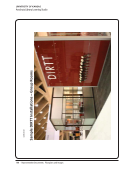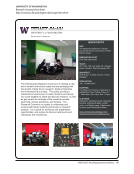SPEC Kit 327: Reconfiguring Service Delivery · 13
service desk by combining reference with circula-
tion and/or more services such as interlibrary loan,
reserves, periodicals, technology assistance, or media
services. Proponents of the consolidated service desk
believe that it centralizes patron service. Because con-
solidated service desks are staffed with paraprofes-
sional staff and even students in many instances, the
librarians who take appointments or serve on-call are
freed from the demands of frontline service to more
closely engage with patrons and work on the strategic
directives of the institution.
The second most common addition in service
points was an information commons. This approach
couples a technology-rich space, specially equipped
for collaboration and group work with library and
other university services that may include advising,
math or writing tutoring, career placement, or study
abroad services. The information commons is gener-
ally coordinated virtually through a web space al-
though some have service desks attached as well.
Respondents were very enthusiastic about these ad-
ditions and quick to note how popular they are with
students.
Although not quite as prevalent as consolidated
service desks, consolidated/central research desks
were the third most common addition. This configu-
ration may result from combining reference desks
with other research desks such as government publi-
cations, or the consolidation of two-or-more subjects’
reference services (e.g., science or music reference) to
create a consolidated approach. Proponents of con-
solidated/central research desks note the librarians
who staff these desks provide excellent service to
patrons taking advantage of the range of available
expertise. This mixing that occurs among the special-
ists amounts to effective cross training and efficient
triage of patron questions.
The fourth most common addition in both ser-
vice points and branch libraries was a small, but very
interesting category that the authors tagged notable
innovations. Only a small group at present, notable
innovations may be harbingers of future service con-
figurations to come. Examples include virtualizations
(defined as replacing a service point or branch library
with its virtual counterpart) of many kinds—library
collections, service points, and embedded library
service providers for strategically targeted groups of
users. Although the ownership for these virtualiza-
tions most likely will be the library, the ownership of
a virtualization may be shared or even owned by a de-
partment where a librarian only participates instead
of being a wholly owned subsidiary of the library.
There were only a few additions of branch librar-
ies in new educational facilities consistent with the
lean budgets that most institutions experienced in
one case, the library took over the management of a
branch library from a university department.
Closures
The most common service point closure reported was
a reference or service desk closed in the making of
a consolidated service desk followed by a service or
research desk closed as a result of the creation of a
consolidated/super research desk. Interestingly, clo-
sures as a result of consolidated media service points
appeared often enough to make special note. In some
cases, media service points were closed after the me-
dia was moved from a closed stack to an open ac-
cess arrangement. In other cases, media services were
closed as a result of a consolidation with circulation
desks or other “older” library technologies such as
microforms, periodicals, or music media.
In terms of branch library closures, science branch
library closures outnumbered other branch library
closures even though several respondents didn’t dis-
tinguish a field other than “branch library closure.”
Because some respondents also reported a connection
between the easy electronic delivery of scientific peri-
odical literature and diminished gatecounts at branch
libraries, the authors observed a trend in these science
library closures.
Consolidations
The most common service point reconfiguration, the
numerous consolidations figured prominently into
all of the additions, closures, and other reconfigura-
tions reported. As noted previously, the word, con-
solidate, may not be standardized in library lexicon as
respondents often used other terms such as integrate,
combine, merge, or expand for consolidate. Also, there
seemed to be a nearly limitless way that library ser-
vice points could be consolidated, although library
service desk by combining reference with circula-
tion and/or more services such as interlibrary loan,
reserves, periodicals, technology assistance, or media
services. Proponents of the consolidated service desk
believe that it centralizes patron service. Because con-
solidated service desks are staffed with paraprofes-
sional staff and even students in many instances, the
librarians who take appointments or serve on-call are
freed from the demands of frontline service to more
closely engage with patrons and work on the strategic
directives of the institution.
The second most common addition in service
points was an information commons. This approach
couples a technology-rich space, specially equipped
for collaboration and group work with library and
other university services that may include advising,
math or writing tutoring, career placement, or study
abroad services. The information commons is gener-
ally coordinated virtually through a web space al-
though some have service desks attached as well.
Respondents were very enthusiastic about these ad-
ditions and quick to note how popular they are with
students.
Although not quite as prevalent as consolidated
service desks, consolidated/central research desks
were the third most common addition. This configu-
ration may result from combining reference desks
with other research desks such as government publi-
cations, or the consolidation of two-or-more subjects’
reference services (e.g., science or music reference) to
create a consolidated approach. Proponents of con-
solidated/central research desks note the librarians
who staff these desks provide excellent service to
patrons taking advantage of the range of available
expertise. This mixing that occurs among the special-
ists amounts to effective cross training and efficient
triage of patron questions.
The fourth most common addition in both ser-
vice points and branch libraries was a small, but very
interesting category that the authors tagged notable
innovations. Only a small group at present, notable
innovations may be harbingers of future service con-
figurations to come. Examples include virtualizations
(defined as replacing a service point or branch library
with its virtual counterpart) of many kinds—library
collections, service points, and embedded library
service providers for strategically targeted groups of
users. Although the ownership for these virtualiza-
tions most likely will be the library, the ownership of
a virtualization may be shared or even owned by a de-
partment where a librarian only participates instead
of being a wholly owned subsidiary of the library.
There were only a few additions of branch librar-
ies in new educational facilities consistent with the
lean budgets that most institutions experienced in
one case, the library took over the management of a
branch library from a university department.
Closures
The most common service point closure reported was
a reference or service desk closed in the making of
a consolidated service desk followed by a service or
research desk closed as a result of the creation of a
consolidated/super research desk. Interestingly, clo-
sures as a result of consolidated media service points
appeared often enough to make special note. In some
cases, media service points were closed after the me-
dia was moved from a closed stack to an open ac-
cess arrangement. In other cases, media services were
closed as a result of a consolidation with circulation
desks or other “older” library technologies such as
microforms, periodicals, or music media.
In terms of branch library closures, science branch
library closures outnumbered other branch library
closures even though several respondents didn’t dis-
tinguish a field other than “branch library closure.”
Because some respondents also reported a connection
between the easy electronic delivery of scientific peri-
odical literature and diminished gatecounts at branch
libraries, the authors observed a trend in these science
library closures.
Consolidations
The most common service point reconfiguration, the
numerous consolidations figured prominently into
all of the additions, closures, and other reconfigura-
tions reported. As noted previously, the word, con-
solidate, may not be standardized in library lexicon as
respondents often used other terms such as integrate,
combine, merge, or expand for consolidate. Also, there
seemed to be a nearly limitless way that library ser-
vice points could be consolidated, although library






















































































































































































































